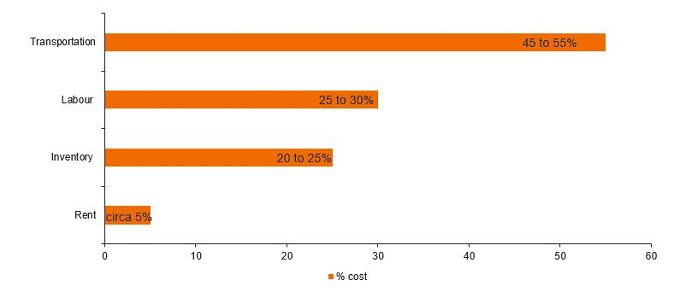Subscribe
Sign up for timely perspectives delivered to your inbox.

The global supply chain crisis is creating further tailwinds for industrial real estate, according to the Global Property Equities Team.
The US industrial real estate market is on pace for a record year of leasing activity. Year-to-date 2021 net absorption (sum of square feet that became physically occupied, minus the sum of square feet that became physically vacant during a specific period) reached an astonishing 366 million square feet through September- 98% above the same period one year ago, 1 and already the most ever recorded in a single year, with another quarter remaining in 2021.
While the supply chain crunch may be a perfect storm for many sectors of the economy, industrial real estate owners have been one of the largest beneficiaries. We explain why.

For decades, supply chains have been globalising, taking advantage of cost differentials across countries, and shifting to a just-in-time model. Developed by Toyota in the early 1970s, and popularised by Dell in the 1990s, the just-in-time supply chain method is the process of minimising static inventory levels by only moving goods right before they are needed. But the pandemic exposed supply chain risks, leaving companies with minimal on-hand inventory, and lengthy lead times preventing products reaching consumers in an acceptable timeframe and causing retailers to miss out on potential sales. These problems have only been exacerbated in recent months, with several trends combining to make the current supply chain crisis even more acute.
Major US ports, including the ports of New York/ New Jersey, Los Angeles and Long Beach are experiencing severe delays in ship arrivals. Globally, there are now more than 600 container ships stuck outside ports, nearly double the number at the start of the year, according to global leading logistics group Kuehne+Nagel as at 15 October 2021. And the problems are more deep-seated than just the ports, with supply chains suffering from shortages of port workers, truck drivers as well as escalating fuel prices.
With the US industrial real estate vacancy rate hitting a record low of 4.1% in the third quarter of 2021,3 occupiers have been left with no choice but to try and outbid their competitors for any warehouse space that becomes available. The shift from just-in-time to just-in-case supply chains (keeping large inventories on hand) is a multi-year structural trend that’s still in its early stages. For now though, companies are simply scrambling to secure space ahead of the upcoming holiday season.
The knock-on impact to industrial real estate fundamentals has been stark, with operating metrics surpassing all historical records. Real estate rent is the smallest component among major cost categories in the supply chain, accounting for less than 5% of an occupiers’ total costs to supply.4 This pales in comparison to transportation and labour costs, which typically account for 55% and 30% respectively, but can rise substantially higher in an inflationary environment. “Commercial real estate costs are just a rounding error,” according to Adam Roth, Director of Global Logistics at NAI Hiffman.

Despite ongoing record growth in rental rates, transportation and labour costs are rising at a much faster pace. Prologis estimates that for every $1 spent on rent, users of logistics real estate spend $5 to US$7 on labour and $10 on transportation. The relatively low cost of ‘mission critical’ industrial warehouse space highlights the underlying pricing power that landlords possess and can continue to benefit from, while at the same time helping offset snowballing costs elsewhere in the supply chain.
It is also worth highlighting that the ownership of real estate is not a labour-intensive endeavour, and therefore industrial landlords, in addition to typically benefiting from significant pricing power, tend to be largely insulated from the rising labour costs impacting their tenants.
As customers endeavour to secure leases in facilities within major population centres, the willingness to pay higher rents has also increased, pushing rental rate growth to record highs. US industrial market rent growth reached 8.3% in 3Q,5 and rents in supply constrained coastal markets have risen considerably more. Average rents for Class A space in New Jersey are 24% higher than twelve months ago. Bidding wars among prospective tenants are no longer uncommon. A seemingly incurable demand-supply imbalance in markets such as Southern California is likely to drive rents even higher. Rexford, one of the leading industrial landlords in the region, recently announced that its portfolio mark-to-market (the gap between average in-place rents and average market rents) now stands at around 27%, providing a substantial revenue growth opportunity.
Prior to the ongoing pandemic-induced global supply chain disruptions, industrial real estate was already enjoying a renaissance of sorts as the critical importance of a robust ecommerce capability had become a well acknowledged fact, acknowledged by even the stodgiest of retailers. The current situation has merely thrown ‘fuel on the fire’. This bodes extremely well for continued healthy demand for industrial real estate.